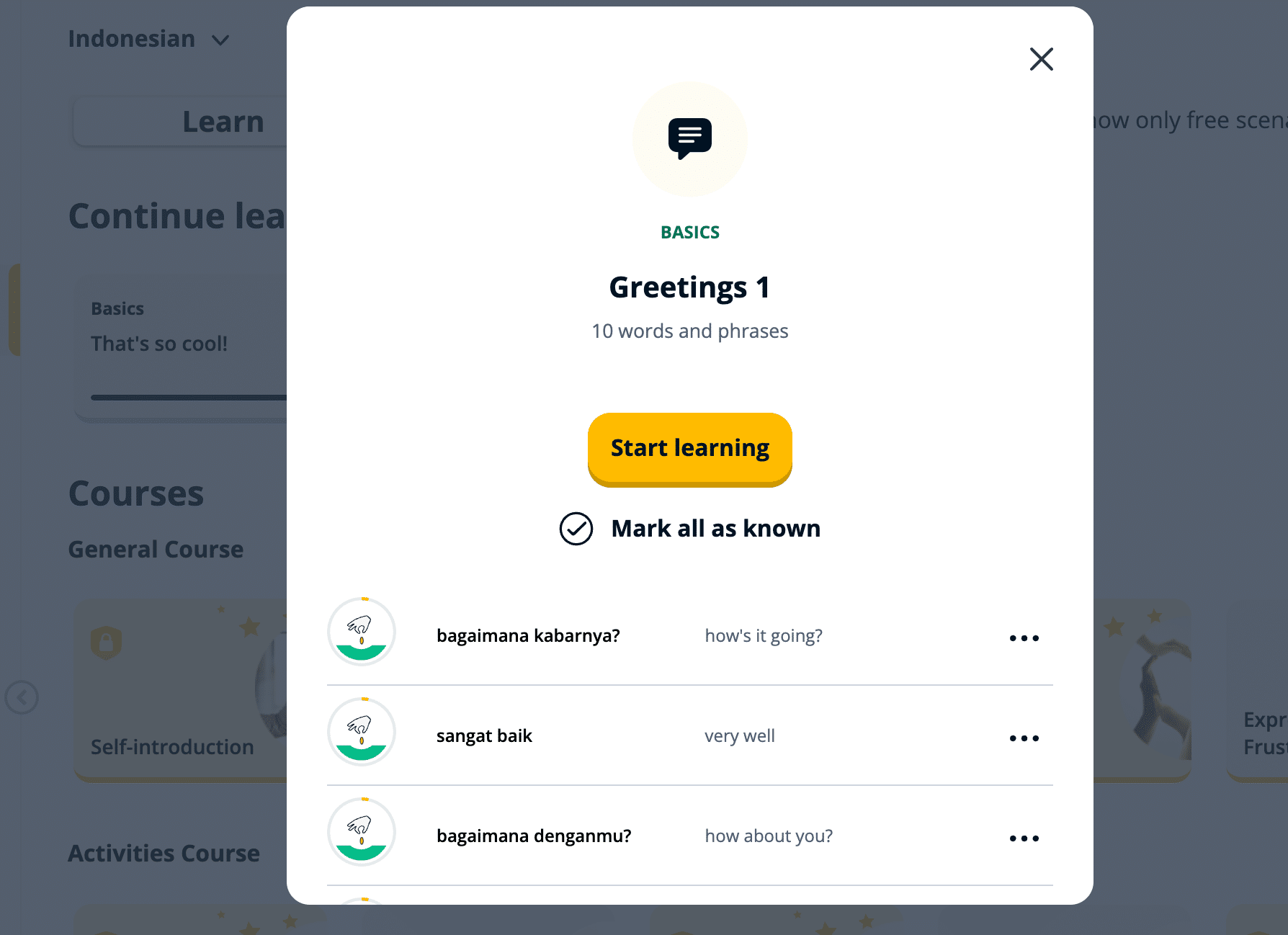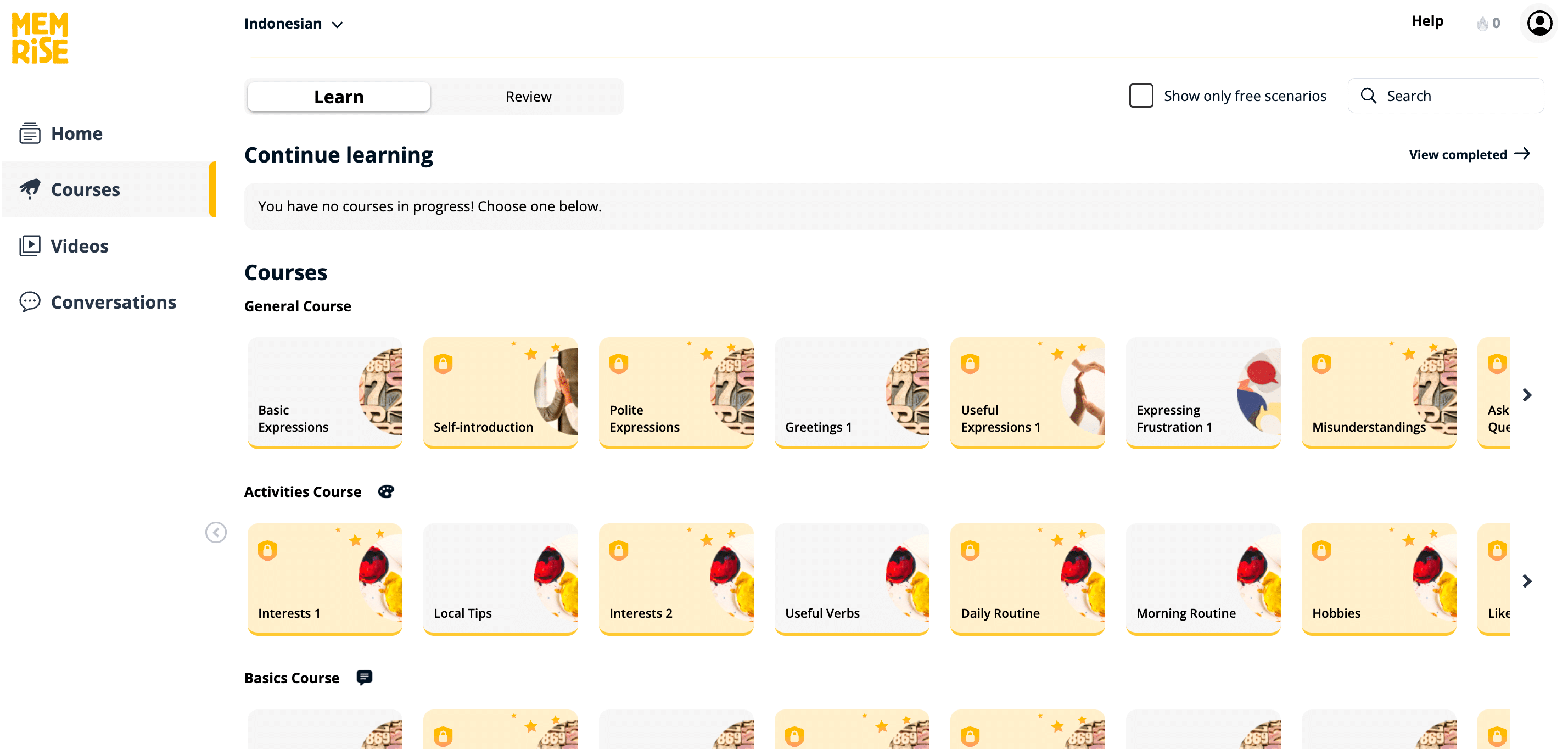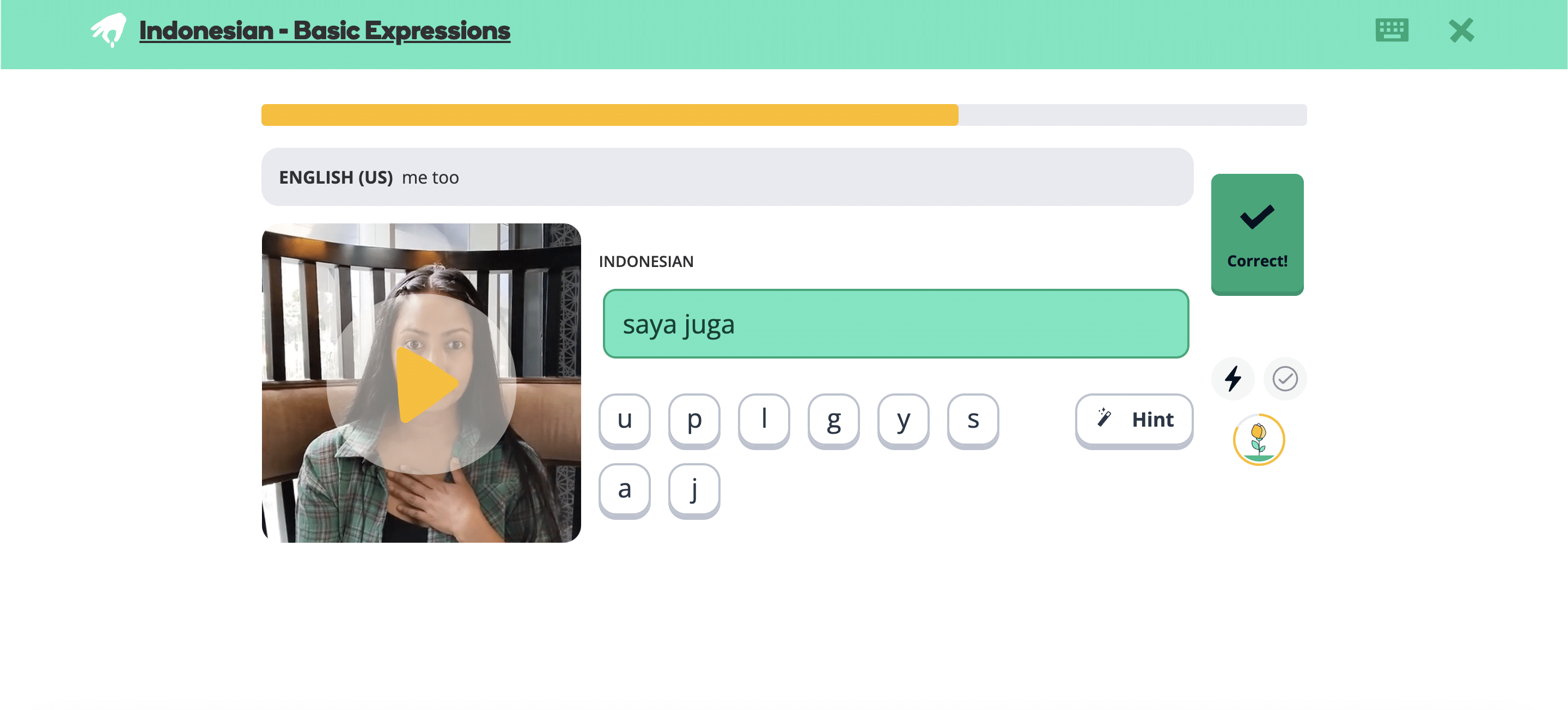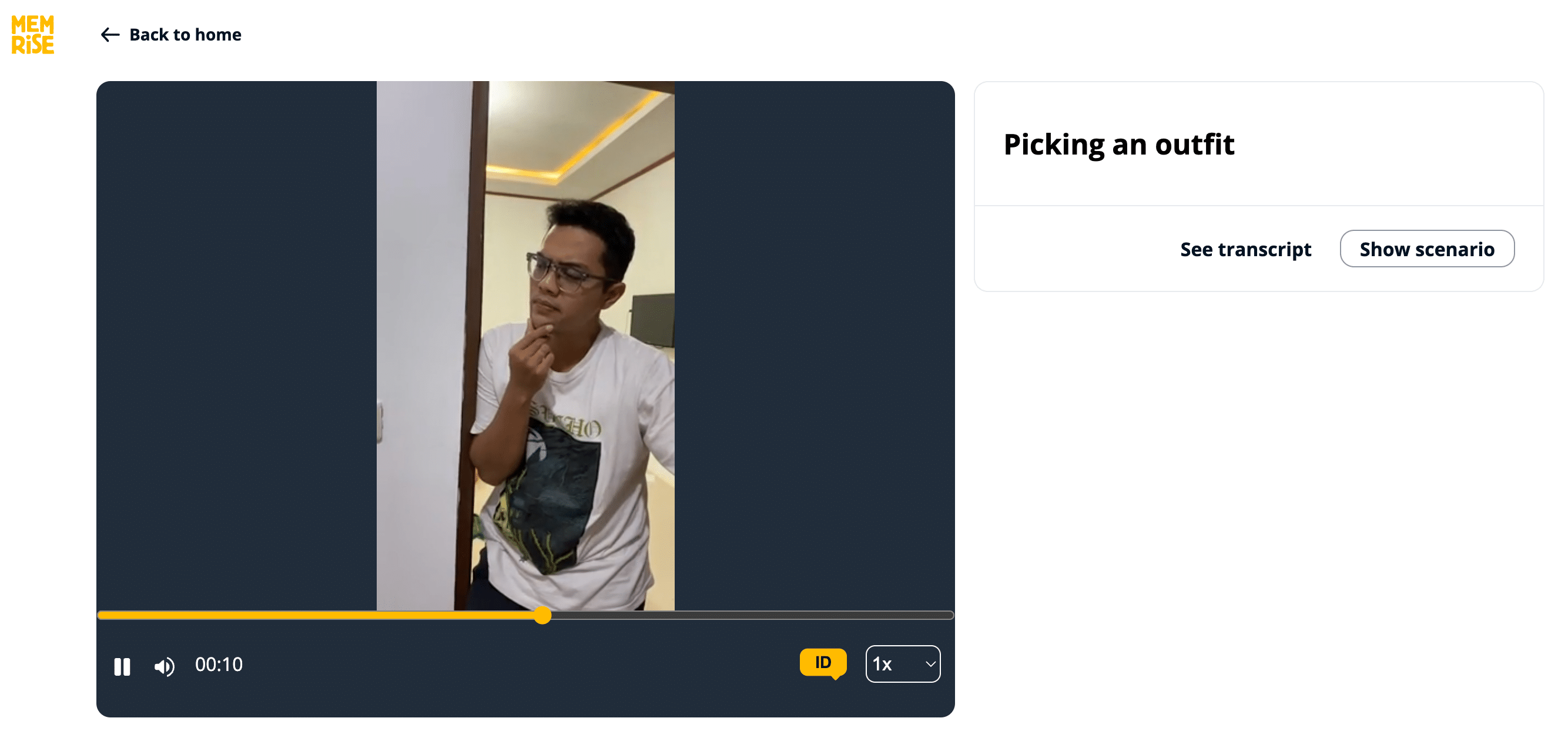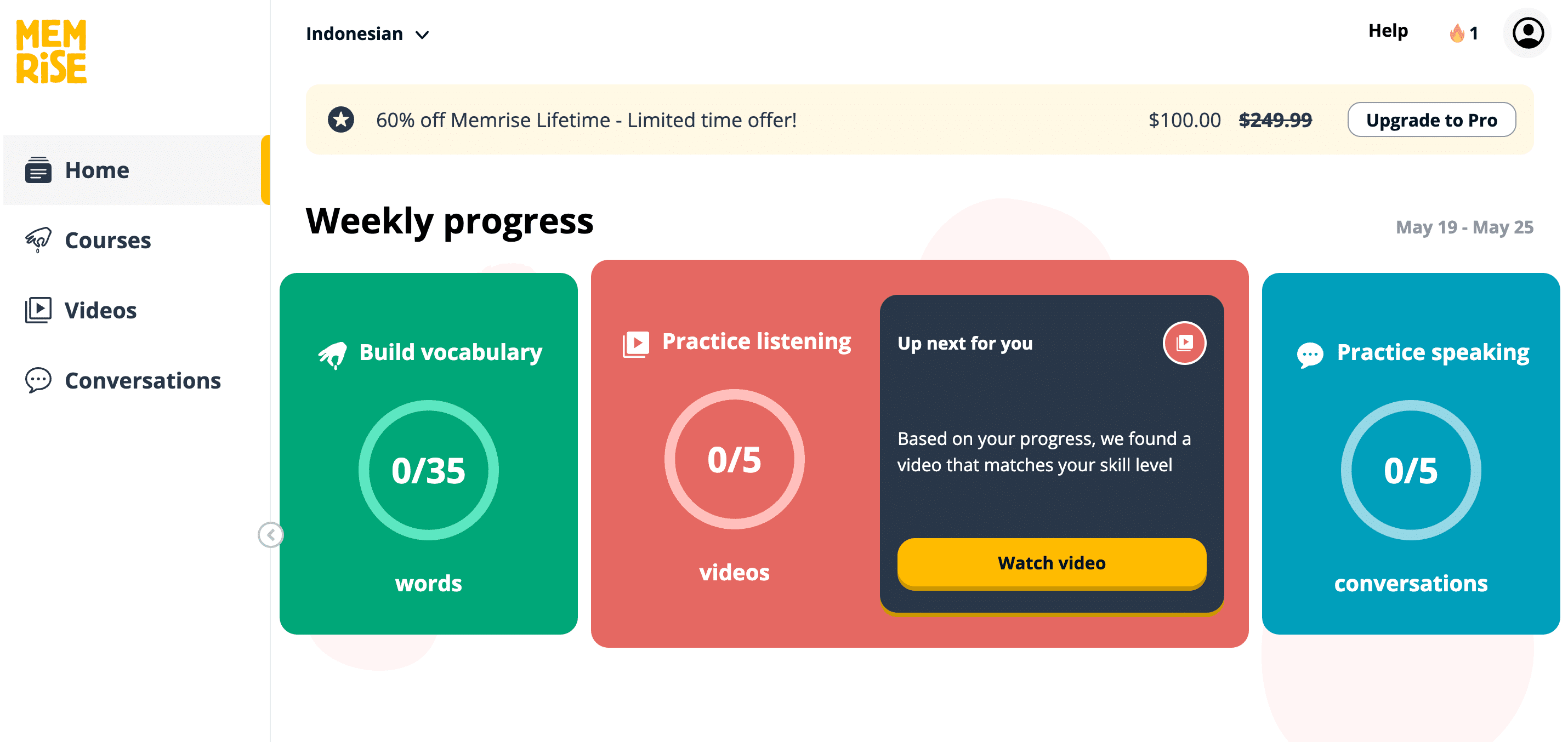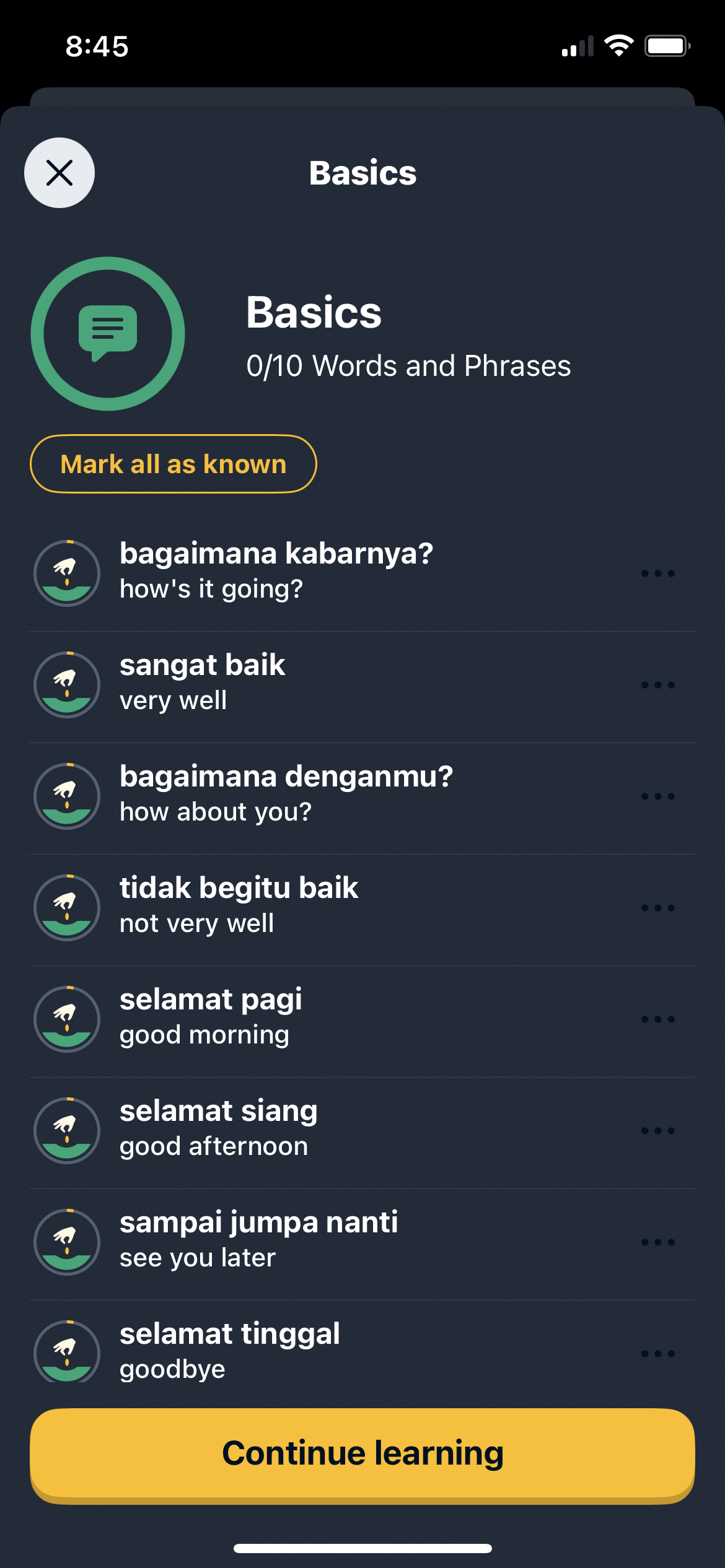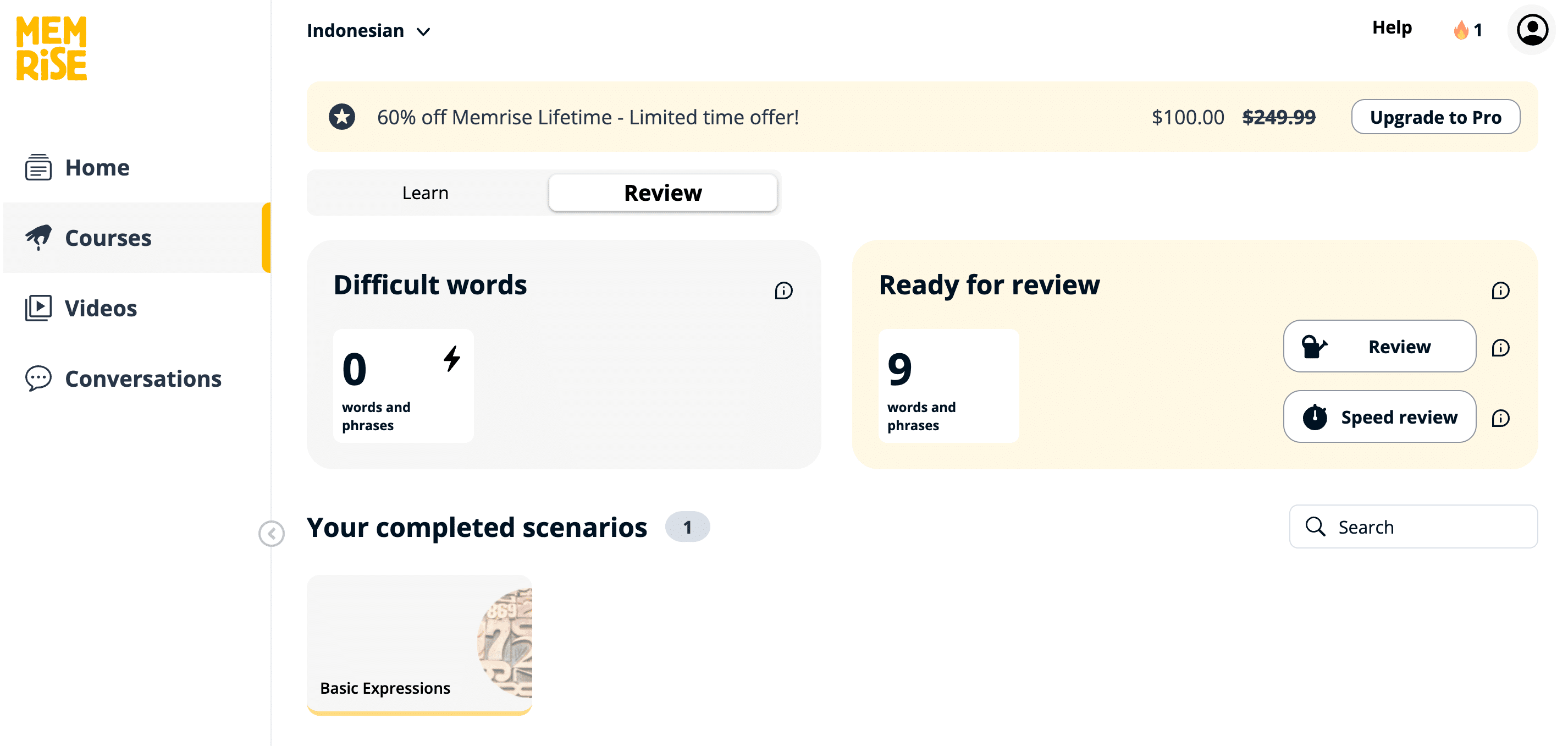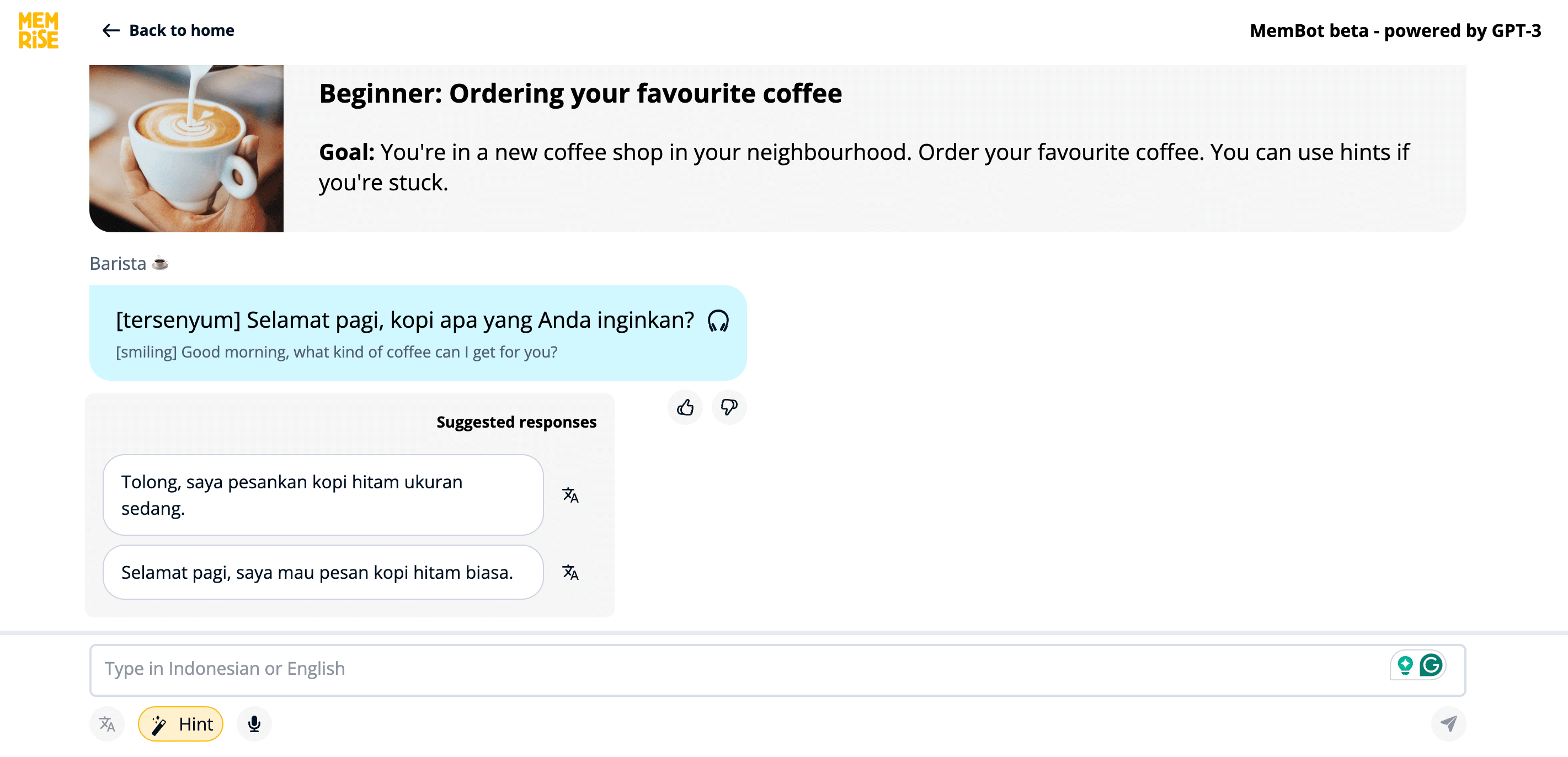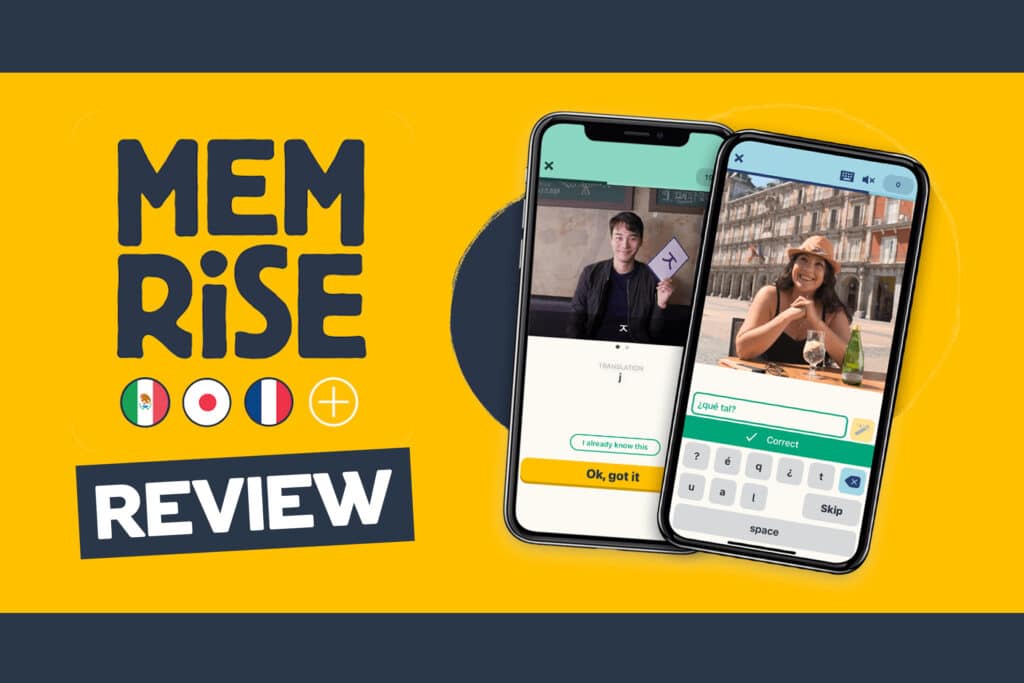
Memrise Review: Lots of High-quality Language Courses, but Limited Free Content
I’ve used Memrise for years to learn more languages than I can count—from ones I now speak fluently to others I just dabbled in. It places a huge focus on teaching you highly important vocabulary words immediately and uses spaced repetition technology, which I’ve always loved.
But Memrise has undergone a big revamp in 2024 with new features and courses, but with the same vocabulary-first and spaced repetition values. So I decided to take up my Indonesian studies again using the Memrise course and was really surprised by the depth of the content.
Contents
- Memrise’s Main Features
- How Memrise Works
- Memrise Cost and Subscription Plans
- Pros of Memrise
- Cons of Memrise
- Alternatives to Memrise
- Is Memrise Worth It?
Download: This blog post is available as a convenient and portable PDF that you can take anywhere. Click here to get a copy. (Download)
Memrise’s Main Features
Spaced Repetition System
Like the name suggests, Memrise helps you “memorize” things using a technique called spaced repetition.
This means that Memrise keeps track of the words you have trouble remembering, and prompts you to review them more often than those you can recall easily.
There have been hundreds of studies showing the effectiveness of spaced repetition as a language learning technique. For example, one study found that with just three minutes of daily SRS practice, EFL students were three times as effective at retaining vocabulary in the long term.
Memrise uses a spaced repetition algorithm to expose you to these words at critical intervals. This ensures the words transfer from your short-term memory to your long-term memory.
While I was exploring the program, I noticed that each deck comes with a preset number of words and phrases in the chosen language, which are divided up into lessons.
The learning process is simple: each word or phrase has its own flashcard, and I could master each flashcard through a series of repetitions.
Each repetition grew my knowledge of the word, and this is represented by the growth stages of a flower.
Offers Tons of Languages on the Community Course Website
When I used Memrise before 2024, it was purely flashcard-based with much less multi-media features (not as many videos, no practice conversations, etc.). And it let you take official Memrise courses and “community courses” created by users.
This meant you could study practically any language, so long as someone had made flashcard decks for it.
Now, Memrise has shifted to only offering their full official courses. But you can still access all the community courses on a separate website called community-courses.memrise.com. I’m still considering this a Memrise feature because it hasn’t eliminated the ability to take community courses—just moved it to another site.
You can make your own courses and flashcard decks on the community site. I personally use it every day to study new Spanish vocabulary I learn while preparing to take the DELE C2 exam.
Full Language Courses with Mini-courses
The Memrise official courses are highly professional with videos, native audio, accurate translations, chatbot conversation practice and much more.
I was extremely impressed by the user-friendly navigation, high level of interaction within the lessons, course structure and depth of the content.
When I started the Indonesian course, I could pick from many different topic-based and leveled courses—a General Course, Activities Course, Basics Course, Education Course, Health Course, Relationships Course and more.
Once you start a course, you’re taken through five-ish minute learning sessions that teach you the words through various multi-media sources. First, you’ll see the word as a flashcard with a video of a native speaker saying it. The first few exercises ask you to select the correct translation out of four options.
The exercises get progressively harder—I went from being asked to select what the speaker was saying in Indonesian (essentially a listening exercise), to being asked to translate the word once I had seen it a few times.
Authentic Native Material
All the official courses include native audio and video in the target language.
You can see this in the screenshots I’ve included of my Indonesian lessons—each word is introduced with a native speaker saying it in the video. I love that the pronunciation is super clear and the quality of the videos is super high, something many programs get wrong.
The lessons also test your listening skills just as often as your recall skills. Every few exercises, I would be asked to type out or select what the native speaker said in the video clip.
While this is a staple in the company-created courses, many user-created decks also have recorded audio. And there’s an option to record audio for your own custom decks.
Another huge plus is that many different accents are represented in both official and user-created courses.
For example, Memrise hosts courses for both Mexican Spanish and Spanish from Spain. And you can find user-created courses in Argentinian Spanish and Chilean Spanish on the community website, just to name a few.
After you complete a lesson, you watch a “scenario.” This is a video clip of native speakers interacting with each other using the vocabulary you’ve learned, and then you grade how well you understood the clip. If you didn’t understand it well, Memrise takes you to a lesson where you learn the words you didn’t know.
I like that these videos are included early on. I completed my first video scenario after the very first Indonesian lesson.
Weekly Progress
There are three displays on the Memrise homepage: “Build vocabulary,” “Practice listening” and “Practice speaking.” These represent your weekly progress towards the goals you’ve set and the practice areas Memrise recommends.
I set my goal to learn 35 new Indonesian words per day, and Memrise assigned me the goal of completing five videos and five conversations per week. Although I’m not sure if this is the same for everyone, or if Memrise set me these goals based on my choice of 35 new words daily.
I really like the layout of this page—it’s clean, easy to navigate and lets me see my progress with a quick glance. I also love the idea of measuring progress by number of tasks completed (such as how many videos I’ve watched) rather than a streak, which honestly doesn’t tell me much other than that I used the app for at least five minutes that day.
How Memrise Works
Build Vocabulary
There are two tabs you’ll see on your course’s page: “Learn” and “Review.” If you haven’t finished a level yet, it will come up under the “Continue learning” section. If not, the next one in your course curriculum will appear.
When starting a new lesson, I could see a list of the vocabulary words I’d be learning beforehand. Hitting “Continue learning” starts the study session. Memrise introduced two new words at a time to me flashcard-style with the same native speaker video pronunciation I mentioned before.
Once you’ve completed several exercises for each word, it grows a flower and becomes part of your “learned” vocabulary.
Review
Memrise has two review features—“Review” and “Speed Review.”
Switching to the review tab showed me how many words were up for review from my Indonesian course and my “completed scenarios”—basically, the lessons I’ve completed.
The “Difficult Words” tab also appears. This includes words and phrases you’ve gotten wrong during your reviews so you can focus on your weakest areas and is available to Premium members (more on this below). Since I just started the Indonesian course and haven’t missed any words yet, I don’t have any in my “Difficult Words” collection.
The regular “Review” feature takes you through translation exercises of the words you’ve learned in previous lessons. I was presented with the English word or phrase then asked to type in the Indonesian translation.
“Speed Review” is a timed practice of words that need to be reviewed. I found this particularly useful with words I thought I knew well since it increased the challenge. Normally Memrise doesn’t suggest Speed Review unless you have a large amount of words to review—like over 30-40.
Difficult Words
This feature is available only to Premium subscribers. It analyzes which words you’ve been having trouble with and prompts you to practice them in a special session. You can also manually mark words as difficult if you want.
These sessions let you review 20 challenging words at a time, though you can have an unlimited total number of difficult words per course. You can also remove a difficult word manually once you’ve learned it.
Practice Listening
I mentioned earlier that “Practice listening” was one of the three study options on the Memrise home screen. Clicking on it opens a video, which features native speakers having conversations suited to your level. The videos only use words you know or that are slightly above your level, then asks you to grade how well you understood everything at the end.
I’ve only learned nine words total in the Indonesian course so far and have already watched two videos.
The first one was way above my level, so Memrise had me learn the words I didn’t understand. The second one was perfect for my level—I understood everything, as it only used words from the first lesson I completed. I personally love this and am a huge believer in immersing yourself in native (but comprehensible) content as soon as possible. Even if it means listening to a basic, one-sided phone conversation—which was the second video I watched on Memrise.
Practice Speaking
The third study tool is Memrise’s “practice speaking” feature, which uses AI to have conversations with you. The AI robot is called MemBot, and every speaking practice session starts with MemBot asking a question or generating a conversation. You’re then supposed to type in your response and send it in the chat, which prompts MemBot to continue the conversation.
I really like this idea, but it’s very apparent that this feature is in its early phases right now. This screenshot is the first conversation I ever had with MemBot after only completing one lesson in the Indonesian course. It was way beyond my level—I had to use the “Translate” option because I didn’t even know what the question meant.
Even after the translation help, I had no idea how to respond. I hadn’t even learned how to say “coffee” at this point, but MemBot was asking me what coffee I’d like to order.
To get past this, I clicked the “Hint” button. This generated the two response options you see in the screenshot, but I barely understood those either. The only reason I had a rough idea of what the response I chose meant was because I had learned words like hitam (black) on Duolingo a few years ago.
So even though I like this feature, I don’t think it’s beneficial until you’ve got several Memrise lessons under your belt. Hopefully the AI will become more adaptive to your actual level as Memrise continues to develop it.
Memrise Cost and Subscription Plans
Memrise has a free version and a paid subscription plan called “Pro.”
The free version lets you access the review, listening and conversation features and various lessons—called “scenarios”—in your courses. But you don’t have access to all the lessons, “difficult words” feature, unlimited videos, etc. You can also only watch three videos per day with a free account and have a limited number of daily conversations available with MemBot.
Memrise Pro unlocks all lessons in your courses and gives you full access to the features.
As of May 2024, Memrise Pro costs $22.99/month, $71.99/year or $100 for lifetime access.
Pros of Memrise
Offers 22 Language Courses
Memrise has created official courses for 22 languages. The common languages include Arabic, Russian, Spanish, Chinese, Japanese, Portuguese, Korean and a few more.
But they also have courses for lesser-studied languages, such as Yoruba, Slovenian, Icelandic and Mongolian.
The course depth differs for each language. For example, the Yoruba course only has a General Course, Basics Course and Introductions Course. Compare that to the Indonesian course I’m taking. But it still includes the same multi-media content.
Based on solid science
Spaced repetition is known to improve memorization, helping you learn new words in a language. And Memrise does spaced repetition in an orderly and seamless fashion. In fact, its interface is so sleek that it’s easy to forget you’re simply working with flashcards.
Real native content
Native content is important for improving your accent and tuning your ear to the language, and Memrise features high-quality audio and video in its official courses.
Customizable learning regimen
The flexibility in what you learn is definitely a plus. And I love how the lessons sort new words and phrases into manageable chunks for learners, normally focusing on 20 to 30 words per lesson.
You can also learn as much or as little as you want with Memrise and even set your own goals for how long you want to spend on the app. The weekly progress on your home page reflects your personal goals and is highly motivating.
Cons of Memrise
Words and phrases taught in isolation
Memrise’s biggest limitation is that it’s great for learning individual words and phrases, but usually in isolation.
The flashcards in the program often present words or phrases by themselves. This can create a sort of “word salad” for you, leading to problems in seamless communication or understanding.
I found this particularly tricky with words that have multiple meanings.
If you’ve learned a word to have a single meaning, seeing it used in a different way to convey another meaning may lead to confusion in conversations.
Lack of grammar explanations and usage practice
Another thing I noticed about Memrise is that in-depth grammar explanations and language usage notes are almost non-existent in the program.
The user-created decks on the community site are not vetted
This isn’t a con of the official Memrise site. But if you’ve used community courses before or are planning to use the community site, beware that the translations aren’t vetted. So if you use a user-created deck, there could be mistakes.
Alternatives to Memrise
Memrise might have everything you’re looking for, but there are a lot of similar apps that might work just as well or better for you. And there are also lots of programs that can help fill in the gaps where Memrise comes up short.
(If you’re looking for even more suggestions, check out our post featuring alternatives to Memrise.)
FluentU
FluentU and Memrise are similar in that they feature native speakers, but FluentU takes it further.
With FluentU, you hear languages in real-world contexts—the way that native speakers actually use them. Just a quick look will give you an idea of the variety of FluentU videos on offer:

FluentU really takes the grunt work out of learning languages, leaving you with nothing but engaging, effective and efficient learning. It’s already hand-picked the best videos for you and organized them by level and topic. All you have to do is choose any video that strikes your fancy to get started!
Each word in the interactive captions comes with a definition, audio, image, example sentences and more.
Access a complete interactive transcript of every video under the Dialogue tab, and easily review words and phrases from the video under Vocab.
You can use FluentU’s unique adaptive quizzes to learn the vocabulary and phrases from the video through fun questions and exercises. Just swipe left or right to see more examples of the word you're studying.

The program even keeps track of what you’re learning and tells you exactly when it’s time for review, giving you a 100% personalized experience.
Start using the FluentU website on your computer or tablet or, better yet, download the FluentU app from the iTunes or Google Play store. Click here to take advantage of our current sale! (Expires at the end of this month.)
Anki
For learners who enjoy Memrise’s flashcard format, Anki is an app solely focused on flashcard learning.
Anki has a huge number of flashcards available (more than 80 million) and it also lets you make your own.
Like Memrise, Anki uses spaced repetition to help you learn new information and remember it later. The review timing can even be customized.
Anki’s flashcard creation system is incredibly flexible, with a customizable card layout and the ability to add audio, images, and clips to your cards.
Duolingo
Duolingo, like Memrise, is mostly structured around language exercises and drills in a gamified user interface with bright colors and engaging feedback.
But Duolingo is popular for a reason; It’s very easy to jump in on a language and quickly start feeling like you’re learning something.
And if you have a hard time keeping up the language learning habit, the app incentivizes you with perks and rewards that motivate you to practice every day and maintain your streak.
You can also check out our post with a more in-depth comparison of Memrise and Duolingo here.
Drops
Drops takes a very visual and game-like approach to language learning—perhaps even more than Duolingo.
Drops claims that they can teach you a language with five minutes per day. Each session is five minutes long and the free version limits you to five minutes every 10 hours.
Like Memrise, Drops uses repetition-based language learning (though the actual spaced repetition technology in Drops is only available in the paid version).
Drops also incorporates mnemonics to aid with learning and lets you mark a word as “learned” if you don’t want to review it anymore.
You can check out our full review of Drops for more info.
Is Memrise Worth It?
Yes—I highly recommend using Memrise for rapidly building your vocabulary and becoming familiar with the sounds and structure of the language.
The native audio is crisp and high-quality, there’s a wide variety of interactive features and the courses jump straight into teaching you words you’ll actually use in real conversations.
But the free version is pretty limited—you’ll get way more out of Memrise if you have the Pro version. So if you don’t want to pay for the Pro version, you’ll definitely need to use other resources with Memrise to fill in any vocabulary gaps.
